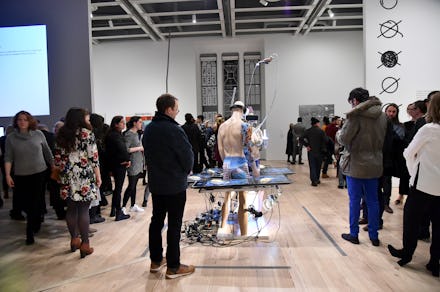Whitney Museum claims apology letter by painter Dana Schutz is a hoax

In a bizarre twist to the controversy surrounding a painting by Dana Schutz, a hoax letter purportedly written by the artist was shared online on Thursday — and then was abruptly revealed to be a fake.
Schutz's painting, "Open Casket," currently on display at the recently opened Whitney Biennial — a contemporary art exhibit at the Whitney Museum of American Art in Manhattan — depicts the body of Emmett Till, the New York Times reported on Tuesday.
The painting is based on the photographs published after Till's death, at his mother's encouragement, showing the open-casket funeral of Till, a black teenager killed by two white men in Mississippi in 1955. As the Times reports, the photographs of Till's mutilated body after he was lynched served as both a "catalyst" for civil rights activism and an ongoing "open wound in American society." Schutz's use of the images in her painting has inspired criticism from many artists of color — some of whom have demanded that the painting be removed from the exhibit.
Protesters and critics of the work appeared to have achieved a victory on Thursday when a heartfelt letter, allegedly signed by Schutz and addressed to curators Christopher Y. Lew and Mia Locks, was shared online.
The letter began, "I am writing to publicly request that my painting, 'Open Casket,' be removed from this year's Whitney Biennial. Though it was not at all my intention to cause harm, many artists have come forward to announce that my depiction of suffering is in turn causing them suffering. I cannot rightly protect a painting at the expense of human beings."
It also said, "If the removal of my painting has been called for by black artists, writers, and activists, I can no longer protect an object at their expense. The painting must go."
Later on Thursday, however, the Whitney Museum announced via its official Twitter account that "An email letter purportedly written by the artist Dana Schutz and circulated to the media is a hoax."
Schutz, a white artist, has said she was inspired to create the painting because of her empathy — as a fellow mother — toward Mamie Till, but several black artists have expressed concerns that Schutz's painting co-opts black death as entertainment, by and for a white audience.
One of those artists, Parker Bright, has been staging a peaceful protest in front of Schutz's painting since Friday, the Times reports, standing in the gallery wearing a T-shirt with the handwritten words "Black Death Spectacle" on the back, in order to block viewers from seeing the painting in full.
Another artist, Hannah Black, wrote an open letter, which circulated online on Monday and was co-signed by a group of other artists of color, in which she asked the "curators and staff of the Whitney biennial" to not only remove Schutz's painting from the exhibit but to destroy it completely.
As you know, this painting depicts the dead body of 14-year-old Emmett Till in the open casket that his mother chose, saying, 'Let the people see what I've seen.' That even the disfigured corpse of a child was not sufficient to move the white gaze from its habitual cold calculation is evident daily and in a myriad of ways, not least the fact that this painting exists at all. In brief: the painting should not be acceptable to anyone who cares or pretends to care about Black people because it is not acceptable for a white person to transmute Black suffering into profit and fun, though the practice has been normalized for a long time.
Schutz has said that she will not sell her painting inspired by Till — but she, and the exhibit's curators, have defended it, New York magazine reported.
New York magazine reported that the fake letter of apology, alleged to be authored by Shutz, was emailed to them "and other publications who had covered the news of the protest."
The same letter was shared on the Frieze on Thursday, with the headline "Dana Schutz asks the Whitney Biennial curators to remove her painting." The site has since But the letter was quickly revealed to be a fake. The Frieze pulled its story from the site, and New York magazine added a correction, saying that it had been contacted by Whitney director of communications Stephen Soba who confirmed that the letter was not written by Schutz.
But the hoax letter, which spread quickly and whose author has not yet been identified, adds a strange twist to the ongoing dialogue surrounding Schutz's painting and the question of how the museum, and the artist, will ultimately respond to fierce and ongoing criticism.